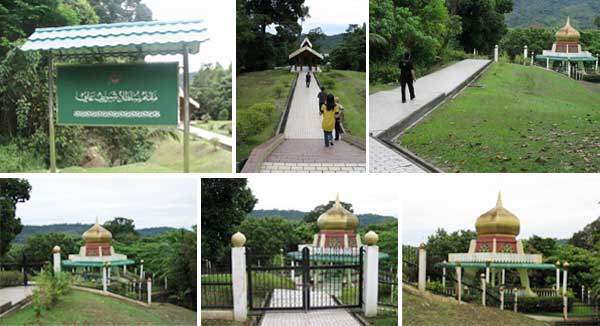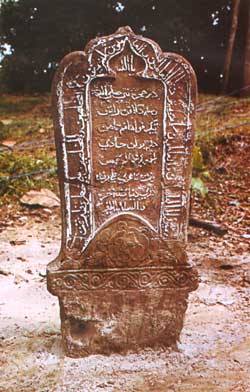
1. The History
The Mausoleum of Sultan Sharif Ali is a historical site in Brunei that likewise, becomes one of the most favourite destinations for pilgrims from the entire part of the world. Once, this site was closed for public since a mega project of research on all historical sites in Brunei, was being undertaken. Such condition means that the mausoleum occupies significant position amongst the Brunei people for either its status as historical or archaeological sites.
Brunei government pays great attention and maintenance to this site for such status above. A refurbishment and renovation have ever been done to maintain this mausoleum. Its former gravestone, of which used woods as the material, had been changed using stones. In addition, to enhance the surrounding scenery, some small buildings were built in beautifully artistic architecture and design.

The dome of the mausoleum resembles a palace with a vault on it, which is aimed at showing the public that this is an Islamic mausoleum. A beautifully-designed fence surrounds the tomb and a footpath was intentionally built from the gateway leading to the mausoleum. At a glance, this tomb looks like a palace owned Sinbad, a comic figure from Arabian. It stands firmly in distinguishing elegance, differs from other mausoleums in Brunei. Its elegance certainly lures us to know, who Sultan Sharif Ali is and how big his merit is to Brunei Kingdom, until such elegance mausoleum was deliberately built special for him.
The Biography of Sultan Sharif Ali
He was Sultan Sharif Ali, an Arabian wandering to Brunei for spreading Islam in this land, Brunei. He was known as a wise and pious Islamic missionary during his duty to spread Islam. His merit and wise, unconsciously, were observed by Sultan Ahmad (1425 A.D.), the second ruler of Brunei Kingdom. As he had no male descendant to succeed his reign, Sultan Ahmad wanted to merry off his daughter, Puteri Ratna Kesuma, to Sultan Sharif Ali. From this point, Sultan Sharif Ali was inaugurated as the third sultan of Brunei Kingdom ruling from 1425 to 1432 A.D.
The inauguration of Sultan Sharif Ali did not solely come from the royal family of Sultan Ahmad. Both Brunei citizens and Brunei royal counsellors agreed Sultan Sharif Ali to be the third Sultan of Brunei because of his deep knowledge in Islam. His merit in spreading Islam cannot be separated from his position as royal ulama in Brunei Kingdom during the role of Sultan Ahmad. For that reason, his marriage to Puteri Ratna Kesuma was aimed at strengthening his position as a Sultan and an ulama as well.
Sultan Sharif Ali was the first sultan of Brunei having no relational genealogy with former sultans of Brunei Kingdom. He came from Thaif, as what mentioned in Tarsilah inscription that was written in the 19th century under the reign of Sultan Muhammad Tajuddin. The inscription says, “….Sharif Ali yang turun dari Taif” (Sultan Sharif Ali who came from Thaif) (Al-Sufri;2001). No matter how he came from outside of Brunei, his investiture as the third Sultan of Brunei Kingdom obtained great support from Brunei citizens.
Many historians attempt to trace back the genealogy of Sultan Sharif Ali for its status as the first sultan of Brunei Kingdom who had no genealogical relations with royal Brunei Kingdom. The result shows that Sultan Sharif Ali was a descendant of the Prophet Muhammad, from Hasan bin Ali bin Abi Thalib. Another source revealing Sultan Sharif Ali‘s genealogy comes from Tarsilah stone saying, “Sharif Ali adalah anak cucu Sayidina Hasan (cucu Rasulullah Salallahu alaihi wassalam) yang datang dari Taif membawa sebilah pedang (Pedang Si Bongkok)…” (Sharif Ali was the son of the grandchild of Sayidina Hasan – Muhammad‘s grandchild – who came from Thaif while holding a sword namely Si Bongkok).
Si Bongkok Sword itself is a royal sword brought by Sultan Sharif Ali when the first time he arrived at Brunei. The sword, up to these days, is hereditarily inherited from generation to generation starting from Sultan Sharif Ali until the present Sultan of Brunei. It is one of two royal swords given by Ottoman Empire in Turkey to the Emirs of Mecca and Egypt. Al Sufri (2001) – when he was visiting Egypt – indeed, affirms that he looked a sword resembling Si Bongkok in Egypt. Now we all see that, perhaps, Sultan Sharif Ali was the Emir of Mecca who escaped away to Brunei when a dispute to hold the next Emir of Mecca took place.
As a pious Muslim, who had ever been an Emir of Mecca, Sultan Sharif Ali was famous as a hardworking ulama who ceaselessly disseminated Islam in Brunei. In addition, a title “Sultan Berkat” (Blessed Sultan) was embedded to him for his favour. During his endeavour to disseminate and develop Islam in Brunei never found any serious problems since the Brunei people had known Islam. However, Islam that came to Brunei since the ninth century was still greatly influenced by Hinduism and Buddha. Upon the hardworking of Sultan Sharif Ali, Islam has become an inveterate culture in daily social intercourse of the Brunei people up to now. He did not only inherit so much spiritual merit, but also physical heritages to the Brunei people that still exist up to these days.
A three-storey masjid and Kota Baru are two of Sultan Sharif Ali‘s physical heritages that were built during his reign. The masjid now can be found in Kampong Sengkurong, approximately 16 kilometres from Bandar Seri Begawan City. Besides, he also fortified a fortress in Kota Baru by ordering his citizens to sink 40 boats containing thousands of stones in a waters area amidst Chermin Island and Keingaran Island. For that reason, that stoned-fortress is commonly called Kota Baru, a historical city for Brunei Darussalam.
While he kept actively built those physical civilizations, Sultan Sharif Ali has established the strong spiritual foundation for the Brunei people by teaching Islam. His teaching method can be seen on his characteristic which shouldered highly Islamic principle. Starting from his reign, which applied Islamic principle firstly, Brunei grows up become a prosperous and safe country. For that reason, the official country‘s name becomes Brunei Darussalam – the addition “Darussalam” means safety.
All of Sultan Sharif Ali‘s merit above clearly carved out in Tarsilah stone saying,…”Maka Sharif Ali itulah kerajaan dinamakan ia Paduka Seri Sultan Berkat yang mengeraskan syariat Rasulullah Sallallahu ‘Alaihi wa Sallam dan berbuat masjid dan segala rakyat Cina berbuat Kota Batu. Tuan Sharif Ali itu pancir salasilah daripada Amirul Mu‘minin Sayidina Hasan cucu Rasulullah (Al-Sufri, 2001).”
It is endlessly to talk about Sultan Sharif Ali‘s merit for the development and advancement of Brunei Darussalam. To commemorate his outstanding merit to Brunei, Sultan Hassanal Bolkiah initiated to build a masjid named Masjid Sultan Sharif Ali in Kampong Sengkurong, 16 km from Bandar Seri Begawan. Standing above a four ha land, this masjid was officially open for public visit on February 1986. Once more, an Islamic university that is dedicated to Sultan Sharif Ali was likewise established on January 1st, 2008 with a name of the Islamic University of Sultan Sharif Ali.
2. The Location
The mausoleum of Sultan Sharif Ali lies in Islamic graveyard located in Kota Baru, Bandar Seri Begawan. This mausoleum is located nearby the Brunei Museum and the Mausoleum of Sultan Bolkiah, the fifth Sultan of Brunei.
3. The Description of the Mausoleum
The mausoleum of Sultan Sharif Ali was built in 836 H (1432 M). It gravestone was carved out an Arabic script saying:
Ya Allah
Dari Hijrah Nabi Sallallahu ‘Alaihi wa Sallam Delapan Ratus Tiga Puluh Enam Tahun dalam bulan Jamadilawal malam Khamis waktu Isya‘ di hari Ali berpindah dari dunia ke akhirat, wassalam bil-khair.
 There is no his complete name “Sultan Sharif Ali” on the gravestone, but there is only “Ali” on it. A source states that before passing away, Sultan Sharif Ali ordered the royal staffers not to write his mundane title like Sultan. He argues that his inauguration as the third Sultan of Brunei was merely aimed at accomplishing Islam‘s obligation hence he did not want his mundane title be written on his gravestone.
There is no his complete name “Sultan Sharif Ali” on the gravestone, but there is only “Ali” on it. A source states that before passing away, Sultan Sharif Ali ordered the royal staffers not to write his mundane title like Sultan. He argues that his inauguration as the third Sultan of Brunei was merely aimed at accomplishing Islam‘s obligation hence he did not want his mundane title be written on his gravestone.
Another argumentation on the absent of “Sultan Sharif” on Sultan Sahrif Ali‘s gravestone, states that “Sharif” is not part of the sultan‘s complete name. “Sharif” before “Ali” derived from Arabic that means “the Honoured.” Therefore, some historians affirm that the complete name of the sultan is “Ali.”
As mentioned on the first paragraph, some refurbishments had been conducted as the efforts to maintain this valuable historical site. Its gravestone, which was formerly made of belian woods, has been replaced with stones. However, the sured date of the refurbishment has not been revealed yet up to now. The only data telling the former gravestone was made of belian wood came from Awang Haji Bakir, together with his friends, who found a wood carved the name of “Ali” that resembles the gravestone on the Mausoleum of Sultan Sharif Ali, in the back of his house.
The bigger refurbishment was once conducted on the dome sheltering the tomb. The former mausoleum of Sultan Sharif Ali was merely a heap of soil with a gravestone made of belian woods on it. Now, the mausoleum seems like an elegant palace surrounded with green scenery of Kota Baru. However, the exact date of the refurbishment has not been revealed yet.
The architecture of the mausoleum‘s dome resembles a palace with Arabian architecture on it. It is surrounded with beautiful motif of fence and vault on the top of the dome. A white footpath was built from the gateway leading to the mausoleum. In addition, the Mausoleum can be included into your travelling list as part of historical and religious tourism while accomplishing pilgrimage to commemorate the glory of Sultan Sharif Ali.
Nanum Sofia(sej/04/07-08)
Translated by Irfan Nugroho (ter/56/09-08)
Reference:
- Al-Sufri, Haji Awang Mohd. Jamil. 2001. Tarsilah Brunei: Sejarah Awal dan Perkembangan Islam. Bandar Seri Begawan, Brunei: Pusat Sejarah Brunei, Kementrian Kebudayaan, Belia dan Sukan.
- _______, 2000. Latar Belakang Sejarah Brunei. Bandar Seri Begawan, Brunei: Pusat Sejarah Brunei, Kementrian Kebudayaan, Belia dan Sukan.
- _______, dkk. 1992. Daulat. Bandar Seri Begawan, Brunei: Jabatan Pusat Sejarah, Kementrian Kebudayaan Belia dan Sukan.
- Anwar, M.K., 2007. The Majestic 40 Years. www.sultanate.com/news_server/2007/5_oct_3.html, Retrieved on July 26th, 2008 at 14.32 a.m.
- Anonym. 2008. An Overview of The Establishement of Universiti Islam Sultan Sharif Ali (UNISSA), www.unissa.edu.bn/index.php?option=com. Retrieved on July 25th, 2008 at 10.29 a.m.
- Jex Lim. e-Borneo.com. 1999. Trekking back in time Brunei history. www.e-borneo.com. Retrieved on July 25th, 2008 at 10.29 a.m.
- Pusat Sejarah Brunei. Tanpa tahun. Info Sejarah: Peristiwa dan Tempat Bersejarah. The Government of Brunei Darussalam Official website: www.history-centre.gov.bn/peristiwa.htm. Retrieved on July 2nd, 2008, 22 Juli 2008 at 1 p.m.
- Pusat Sejarah Brunei. 2006. Info Sejarah: Sultan-sultan Brunei. The Government of Brunei Darussalam Official website: www.history-centre.gov.bn /sultanbrunei.htm. Retrieved on July 2nd, 2008, 22 Juli 2008 at 1 p.m.
Photo Credit
- The Center for Research and Development of Malay Culture
- Brunei History Center
- Al-Sufri, Haji Awang Mohd., 2000. Latar Belakang Sejarah Brunei. Bandar Seri Begawan, Brunei: Pusat Sejarah Brunei, Kementrian Kebudayaan, Belia dan Sukan.
Read : 44.058 time(s).
Insert your comment here :